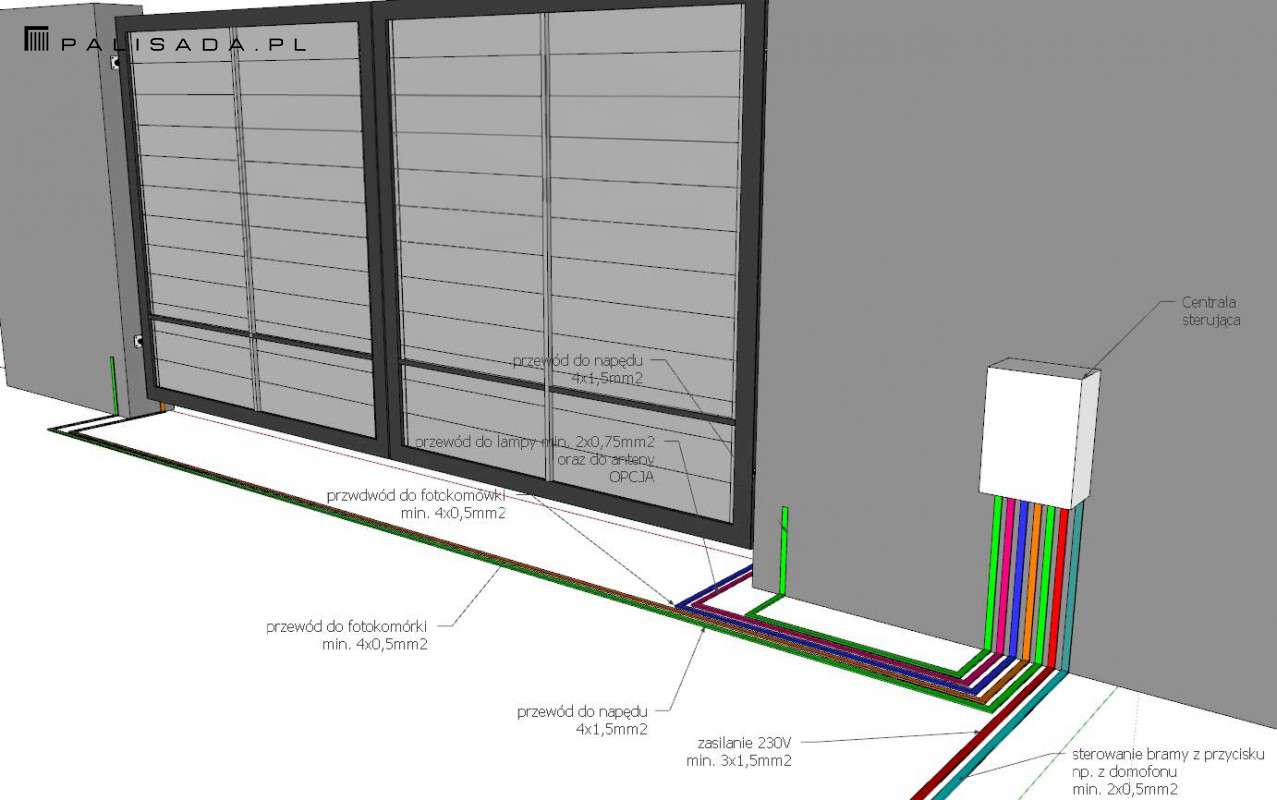
Gate systems, swing gates, and sliding gates should be equipped with remote controls. As a fencing manufacturer, we offer comprehensive installation services along with automation. However, this requires some wiring preparation. Below are a few guidelines and a standard description of what it should look like.
Sliding and Folding Entrance Gate – Cable Placement
If you want your sliding and folding entrance gate to work flawlessly, the power cable must be located in a sheltered place. For long-lasting installation, consider purchasing gel-coated ground cables within protective sleeves.
Currently, folding and sliding gates are often installed on paved driveways. It’s worthwhile to do the wiring before laying the pavement to avoid future disassembly.
Elements of Security for Swing, Folding, and Sliding Gates
Automation should be reliable, so it’s valuable to equip it with a 24 V motor, ensuring continuous operation, along with a control unit that allows for smooth starts and slowdowns. Additional accessories, such as a Wi-Fi control module and an energy-saving module, should be connected to the gate.
Automatic swing, folding, and sliding gates should include built-in photocells to prevent crushing. It’s advisable to consider installing these both before and behind the gate line.
Cabling for Swing, Folding, and Sliding Gates
The standard cabling for folding and swing entrance gates should include the following elements:
- 230 V power cable (min. 3 x 1.5 mm2) – conducted from the cabinet with fuses to the location of the control unit installation.
- 4 x 0.5mm2 cable from each photocell to the control unit.
- Power cable for the actuators (min. 3 x 1.5 mm2) – conducted from the first and second actuators (on the opposite side of the entrance) to the location of the control unit installation.
In the case of sliding gates, only one drive is installed, so the cabling should look as follows:
- 230 V power cable (min. 3 x 1.5 mm2) – conducted from the cabinet with fuses to the foundation of the sliding gate.
- 4 x 0.5mm2 cable from each photocell to the foundation.
Additionally, automation can be supplemented with warning elements, such as a warning light and antenna to extend the remote control range. In this case, appropriate cabling should be prepared:
- Cable for the warning light (min. 2 x 0.75 mm2) – from the installation point to the control unit / foundation.
- RG58 coaxial cable for the antenna – from the installation point to the control unit / foundation.
If a sliding gate enters a pedestrian gate, it’s worth installing protection that will block the gate’s movement when the pedestrian gate is open. For this, a 2 x 1mm2 cable is required. During cabling, it’s also possible to lead control cables (2 x 1 mm2) from the foundation, e.g., from a relay on the garage wall.
Automating Swing and Sliding Gates for Intercom Use
Automatic swing and sliding gates can be installed to open them from an intercom. To do this, a 2 x 1 mm2 cable should be run from the intercom control unit to the automation control unit.
Interested in our automatic entrance gate installations? Check out: Fencing Installation Wrocław
Interested in our offer? Give us a call! +48 71 311 72 91
Gate – Cabling
Standard cabling for intercoms and digital video intercoms for gates includes such elements as:
- Control cable (min. 4 x 0.5 mm2) from the intercom to the cabinet with fuses.
- Cable to the handset (min. 4 x 0.5 mm2) from the cabinet with fuses to the mounting point.
- Electromagnetic lock cable (2 x 0.5 mm2) from the intercom to the location of the gate catch installation, at a height of approximately 1 m.